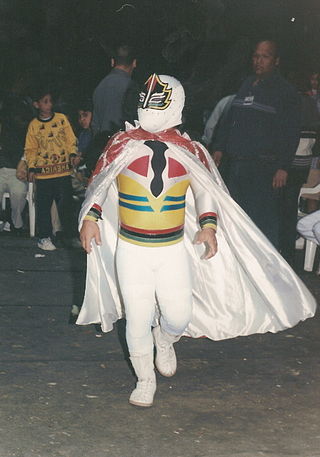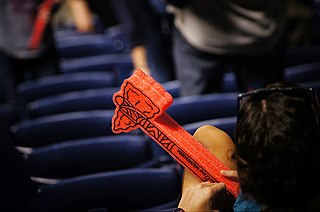
Dwarfism is a condition of people and animals marked by unusually small size or short stature. In humans, it is sometimes defined as an adult height of less than 147 centimetres, regardless of sex; the average adult height among people with dwarfism is 120 centimetres (4 ft). Disproportionate dwarfism is characterized by either short limbs or a short torso. In cases of proportionate dwarfism, both the limbs and torso are unusually small. Intelligence is usually normal, and most people with it have a nearly normal life expectancy. People with dwarfism can usually bear children, although there are additional risks to the mother and child depending upon the underlying condition.

A mascot is any human, animal, or object thought to bring luck, or anything used to represent a group with a common public identity, such as a school, sports team, society, military unit, or brand name. Mascots are also used as fictional, representative spokespeople for consumer products.
Dwarf-tossing, also called midget-tossing, is a pub/bar attraction or activity in which people with dwarfism, wearing special padded clothing or Velcro costumes, are thrown onto mattresses or at Velcro-coated walls. Participants compete to throw the person with dwarfism the farthest. Dwarf-tossing was started in Australia as a form of pub entertainment in the early 1980s. A related, formerly practiced activity was dwarf-bowling, in which a person with dwarfism was placed on a skateboard and used as a bowling ball.
Little People of America (LPA) is a 501(c)(3) non-profit organization which provides support, resources, and information to individuals with dwarfism and their families.

Dickinson High School is a public high school located in Dickinson, North Dakota. It currently serves about 1,060 students and is a part of the Dickinson Public Schools system. The official school colors are orange and black and the athletic teams are known as the Midgets.
Redskin is a slang term for Native Americans in the United States and First Nations in Canada. The term redskin underwent pejoration through the 19th to early 20th centuries and in contemporary dictionaries of American English, it is labeled as offensive, disparaging, or insulting. Although the term has almost disappeared from contemporary use, it remains in use as a sports team name. The most prominent was the NFL's Washington Redskins, who resisted decades of opposition before retiring the name in 2020 following renewed attention to racial justice in the wake of the murder of George Floyd and subsequent protests. While the usage by other teams has been declining steadily, 37 high schools in the United States continue to be Redskins. School administrators and alumni assert that their use of the name is honoring their local tradition and not insulting to Native Americans.

Butternut squash, known in Australia and New Zealand as butternut pumpkin or gramma, is a type of winter squash that grows on a vine. It has a sweet, nutty taste similar to that of a pumpkin. It has tan-yellow skin and orange fleshy pulp with a compartment of seeds in the blossom end. When ripening, the flesh turns increasingly deep orange due to its rich content of beta-carotene, a provitamin A compound.

Midget wrestling is professional wrestling involving people of exceptionally short stature. Its heyday was in the 1950s and 1960s, when wrestlers such as Little Beaver, Lord Littlebrook, toured North America, and Sky Low Low was the first holder of the National Wrestling Alliance's World Midget Championship. In the following couple of decades, more wrestlers became prominent in North America, including foreign wrestlers like Japan's Little Tokyo.
Minor ice hockey or minor hockey is an umbrella term for amateur ice hockey which is played below the junior age level. Players are classified by age, with each age group playing in its own league. The rules, especially as it relates to body contact, vary from class to class. In North America, the rules are governed by the national bodies, Hockey Canada and USA Hockey, while local hockey associations administer players and leagues for their region. Many provinces and states organize regional and provincial championship tournaments, and the highest age groups in Canada and the United States also participate in national championships.

Stereotypes of Indigenous peoples of Canada and the United States of America include many ethnic stereotypes found worldwide which include historical misrepresentations and the oversimplification of hundreds of Indigenous cultures. Negative stereotypes are associated with prejudice and discrimination that continue to affect the lives of Indigenous peoples.
Midgetville refers to real or legendary communities of "midgets", people with forms of dwarfism who are normally proportioned, or collections of small "midget-sized" houses. Real or legendary, they are at times given fanciful qualities. Some "real" ones may play on mythology for tourism purposes. Hence some descriptions are not meant to imply anything concerning ordinary or real people with dwarfism.

Since the 1960s, the issue of Native American and First Nations names and images being used by sports teams as mascots has been the subject of increasing public controversy in the United States and Canada. This has been a period of rising Indigenous civil rights movements, and Native Americans and their supporters object to the use of images and names in a manner and context they consider derogatory. They have conducted numerous protests and tried to educate the public on this issue.

Midget Gems are chewy, firm sweets similar to wine gums but much harder. They are manufactured from sugar and glucose syrup, corn starch and/or various other starches, animal gelatin, and various colourings and flavouring.

Several dwarfs to have had their histories recorded were employed as court dwarfs. They were owned and traded amongst people of the court, and delivered as gifts to fellow kings and queens.

The Washington Redskins name controversy involved the name and logo previously used by the Washington Commanders, a National Football League (NFL) franchise located in the Washington metropolitan area. In the 1960s, the team's longtime name—the Redskins—and the associated logo began to draw criticism from Native American groups and individuals. The topic, part of the larger Native American mascot controversy, began receiving widespread public attention in the 1990s. In 2020, the team responded to economic pressure in the wake of the George Floyd protests by retiring the name and logo. The team called itself the "Washington Football Team" before rebranding as the Commanders in 2022.

The term Mini-Estrella is used in lucha libre to describe a division of short professional wrestlers or luchadors, some of whom have dwarfism. The Mexican Mini-Estrellas are comparable to midget wrestlers who compete internationally, but with the notable exception that some of the Mini-Estrellas do not have dwarfism but are simply short. Some Mini-Estrellas have later on moved on to work as regular sized competitors. The Mini-Estrellas have been featured in several promotions outside Mexico, most notably World Wrestling Entertainment (WWE) and Total Nonstop Action Wrestling (TNA).
Sports teams named Redskins are part of the larger controversy regarding the use of Native American names, images and symbols by non-native sports teams. Teams of this name have received particular public attention because the term redskin is now generally regarded as disparaging and offensive.

The CMLL World Micro-Estrellas Championship is a professional wrestling championship promoted by the Mexican lucha libre wrestling-based promotion Consejo Mundial de Lucha Libre. The championship is exclusively competed for in the Micro-Estrellas, or Micros, division where all competitors have dwarfism.
Estherville–Lincoln Central Community School District (ELC) is a rural public school district headquartered in Estherville, Iowa.












